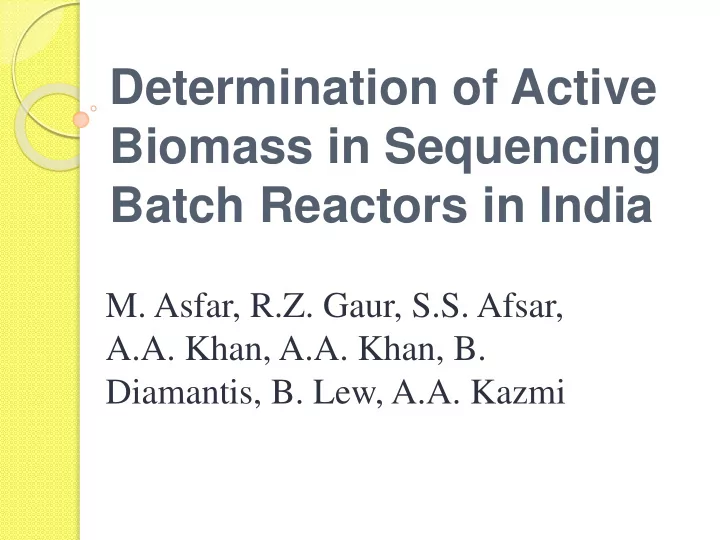

Determination of Active Biomass in Sequencing Batch Reactors in India M. Asfar, R.Z. Gaur, S.S. Afsar, A.A. Khan, A.A. Khan, B. Diamantis, B. Lew, A.A. Kazmi
Wastewater Treatment by Aerobic Systems High BOD, COD and nutrients removal >>>>> Microorganism growth = Excess sludge
Excess Microorganisms Activated Excess Sludge Excess sludge is wasted (WAS) Slowly biodegradable organics/ or limited BOD Endogenous respiration Reduction of Volatile Solids
SBR- Sequencing Batch Reactor Small communities Sludge treatment 4
Objective To assess the active biomass fraction in SBR systems for small communities
Activated Sludge Monitoring Specific Oxygen Uptake Rate (SOUR) Temperature pH MLSS, MLVSS SVI
OUR Variation with SRT SBR- Noida (50) SBR- Noida (54)SBR- PunjabASP- Haridwar SBR- Rishikesh 140 18 16 120 14 OUR (ml/h/g VSS) 100 12 80 SRT (d) 10 8 60 6 40 4 20 2 0 0 SBR- Noida SBR- Noida SBR- Punjab ASP- SBR- (50) (54) Haridwar Rishikesh
Batch Study on OUR and Active Biomass Fraction Decay 30 1 OUR F remaining 0,9 25 0,8 OUR (mg/L /h) 0,7 20 Fraction (%) 0,6 15 0,5 0,4 10 0,3 0,2 5 0,1 0 0 0 5 10 15 20 Time (Min.)
Volatile Solids Fraction Decay 10000 MLVSS (mg/L) 1000 y = 2895.e -0.24x 100 R² = 0.971 10 1 0 2 4 6 8 10 Time (days ) 10000 MLVSS(mg/L) 1000 100 0 5 10 15 20 25 30 35 Time (days)
Temporal variation of BOD Influent BOD Effluent BOD BOD removal 180 100 160 80 140 BOD Removal (%) 120 BOD (mg/L) 60 100 80 40 60 40 20 20 0 0 0 5 10 15 20 25 30 35 40 45 50 55 60 65 70 75 80 85 90 Time (days)
MLSS and SVI with sludge recycling MLSS SVI 6000 400 350 5000 300 4000 250 MLSS (mg/L) SVI (mL/g) 3000 200 150 2000 100 1000 50 0 0 0 10 20 30 40 50 60 70 80 90 100 110 Time (days)
Conclusions The SBR systems can be a good solution for wastewater treatment for small communities- BOD removal higher than 80%. Sludge treatment (MLVSS) can be achieved in the SBR system itself: MLVSS reduction and stabilization; Improved SVI However, increase in MLSS (non organic)
Recommend
More recommend